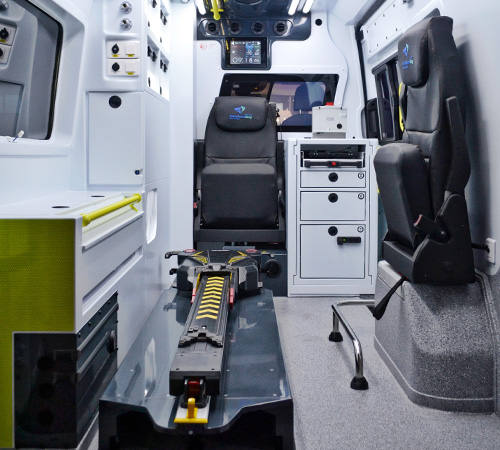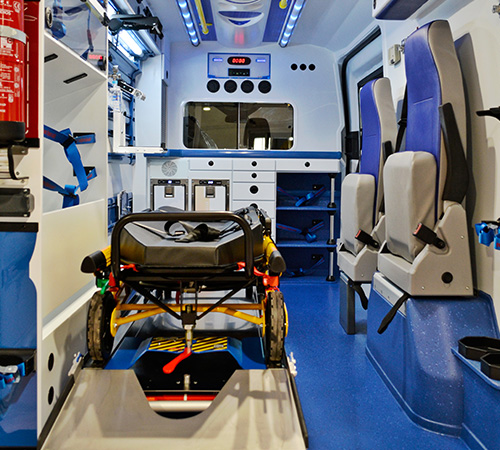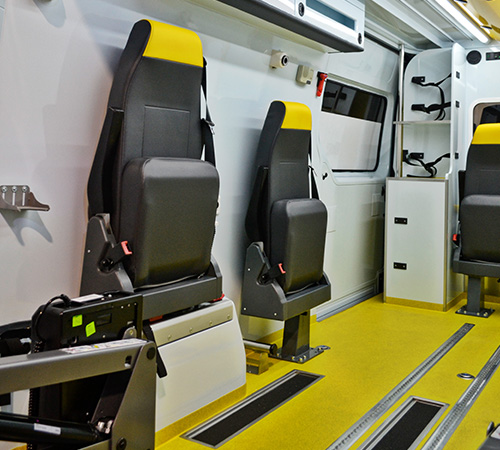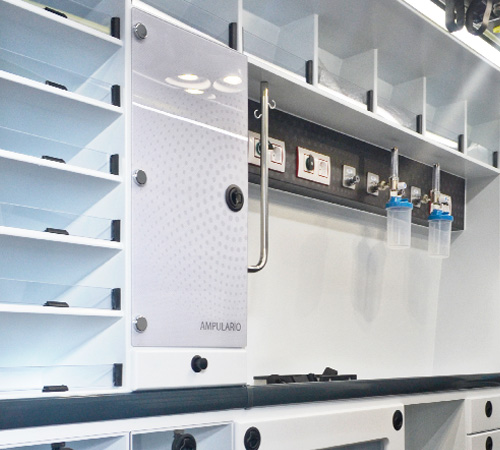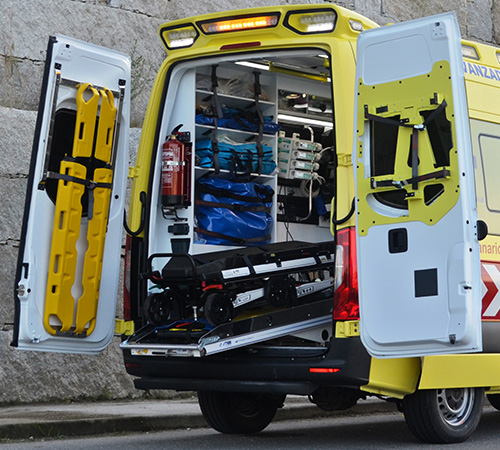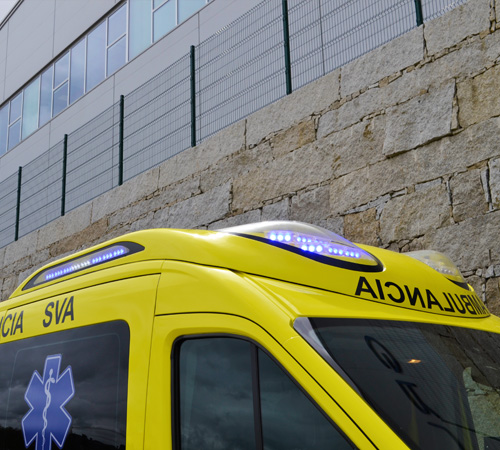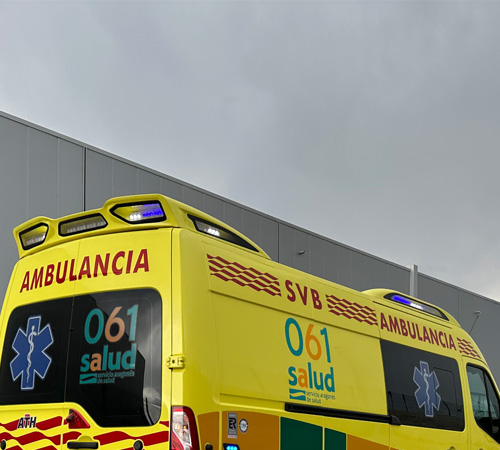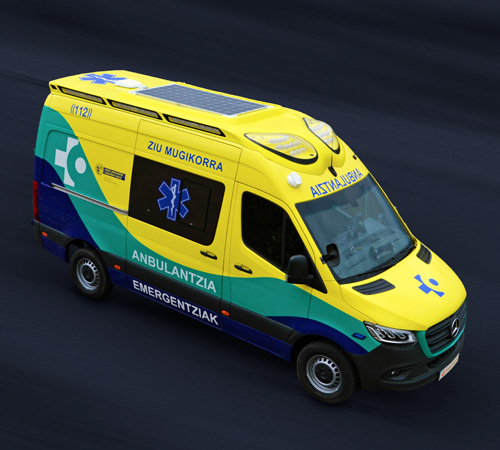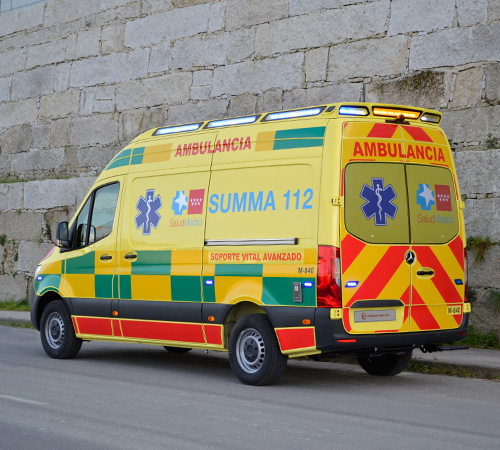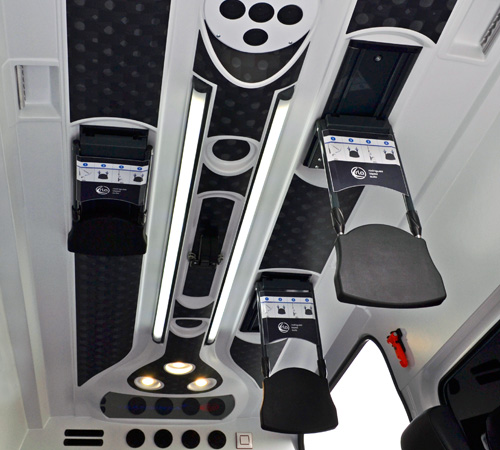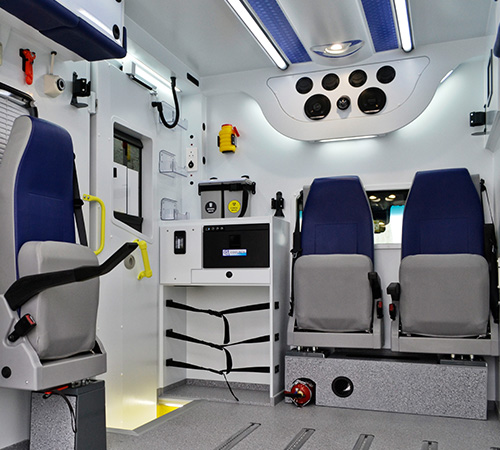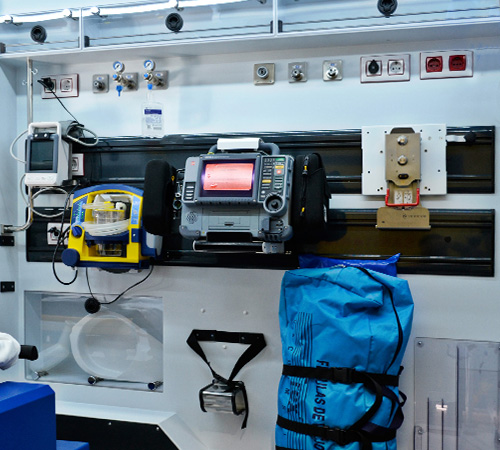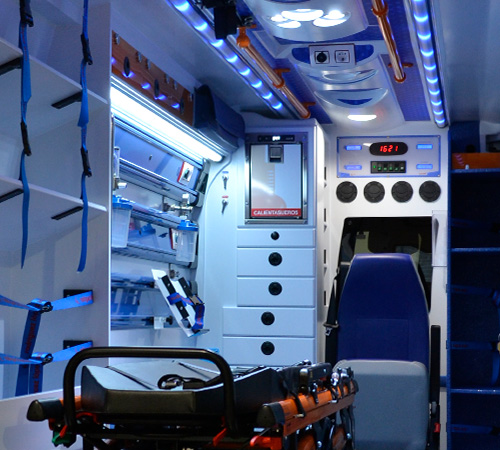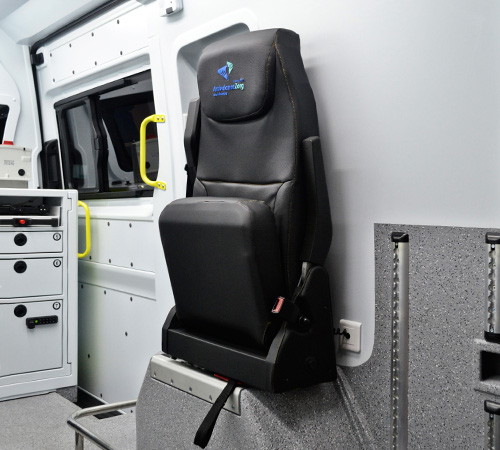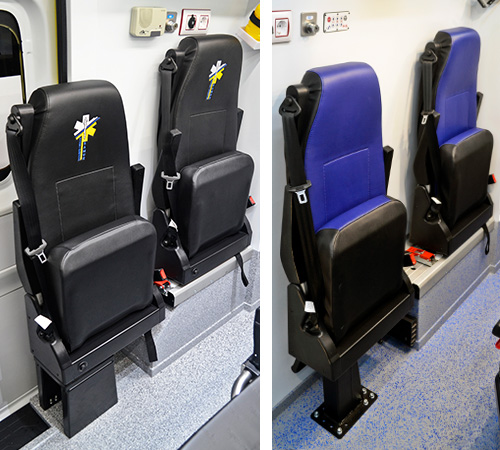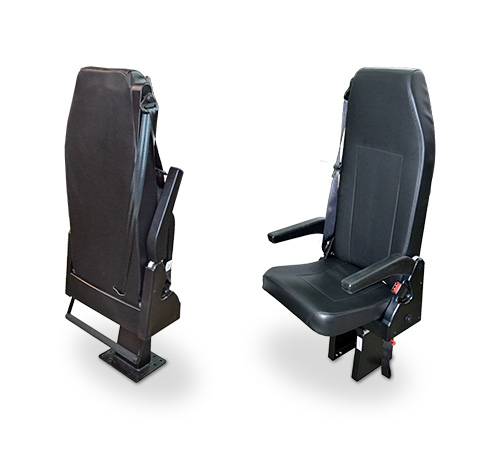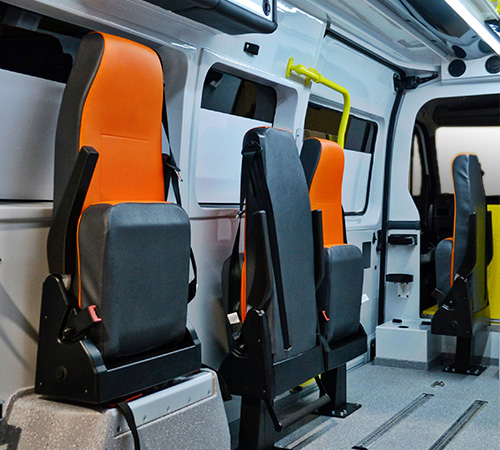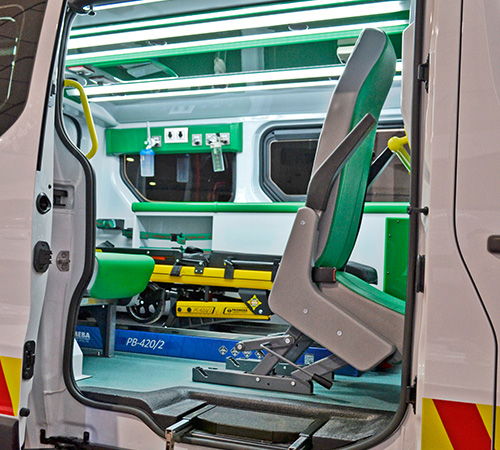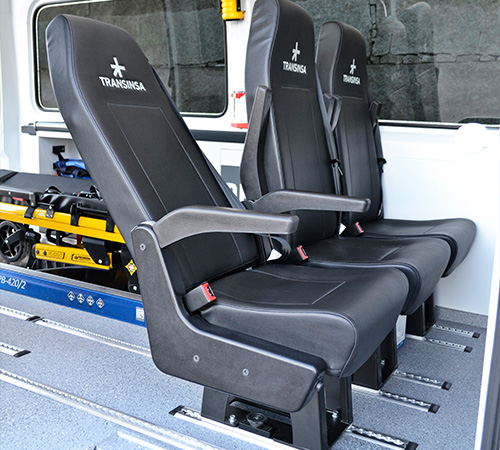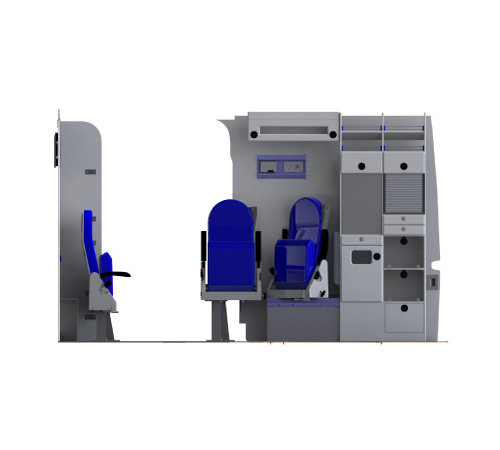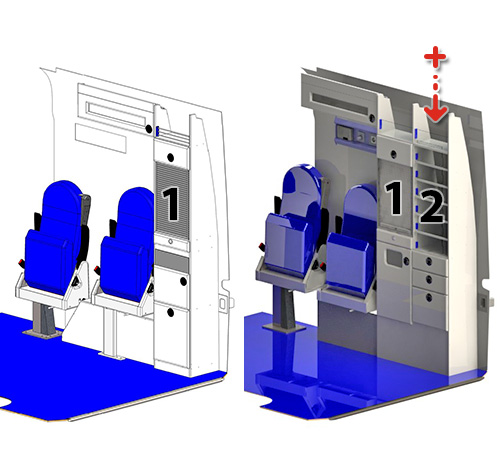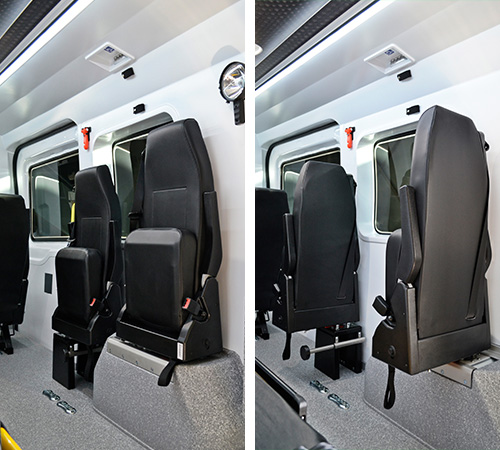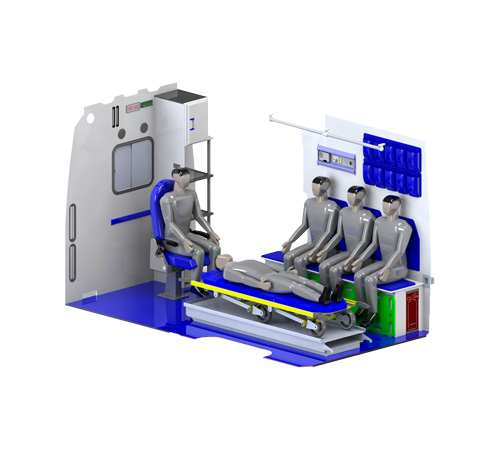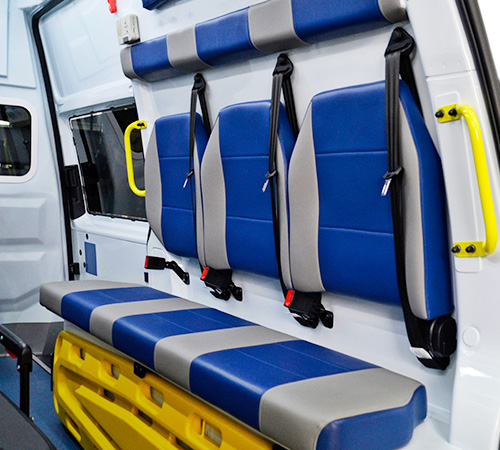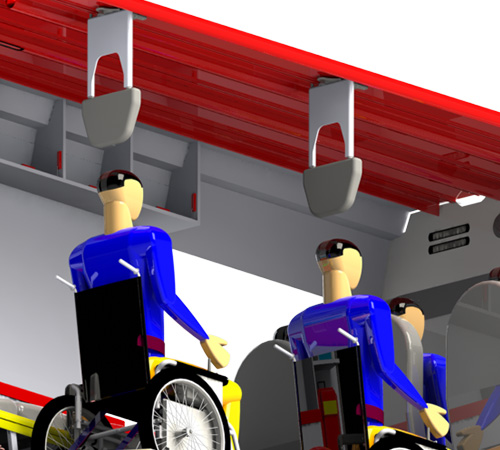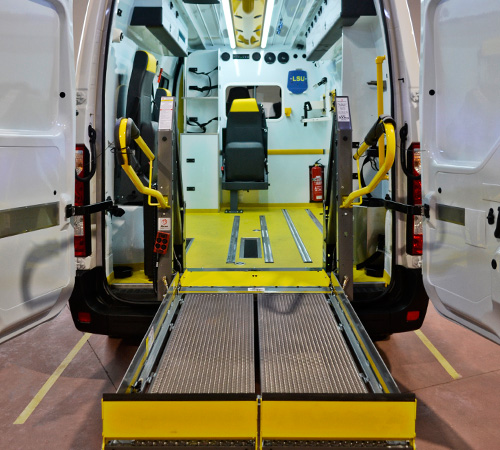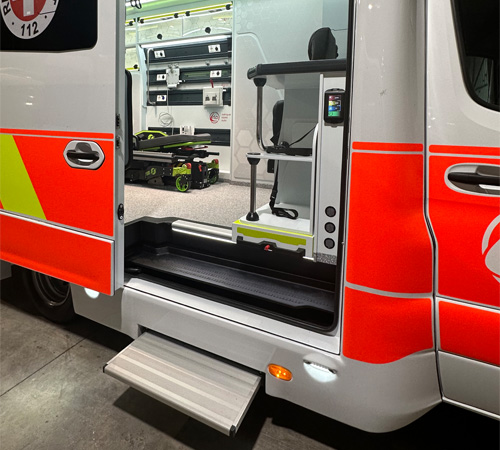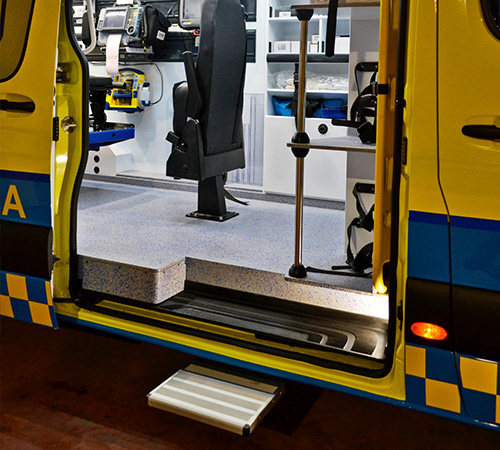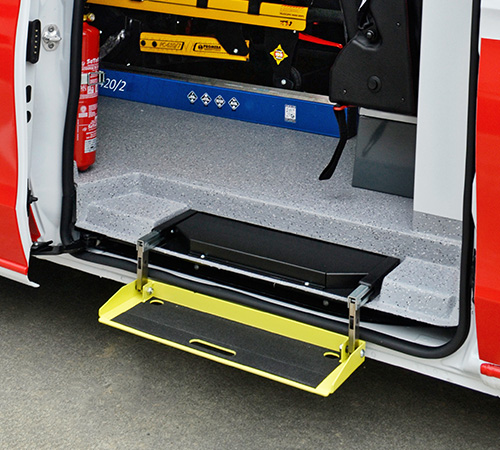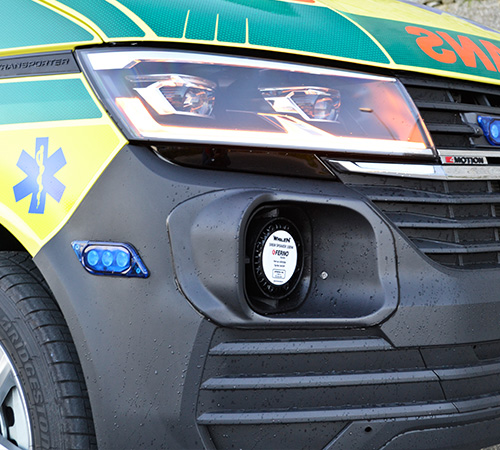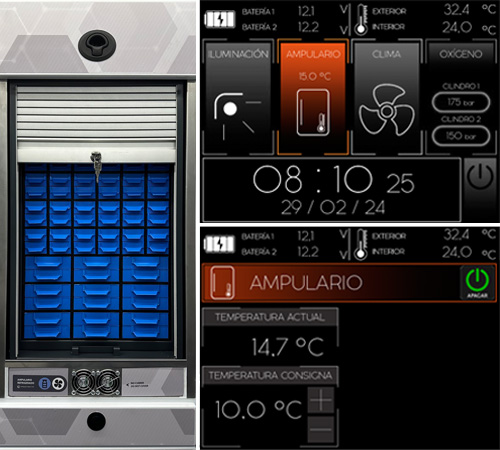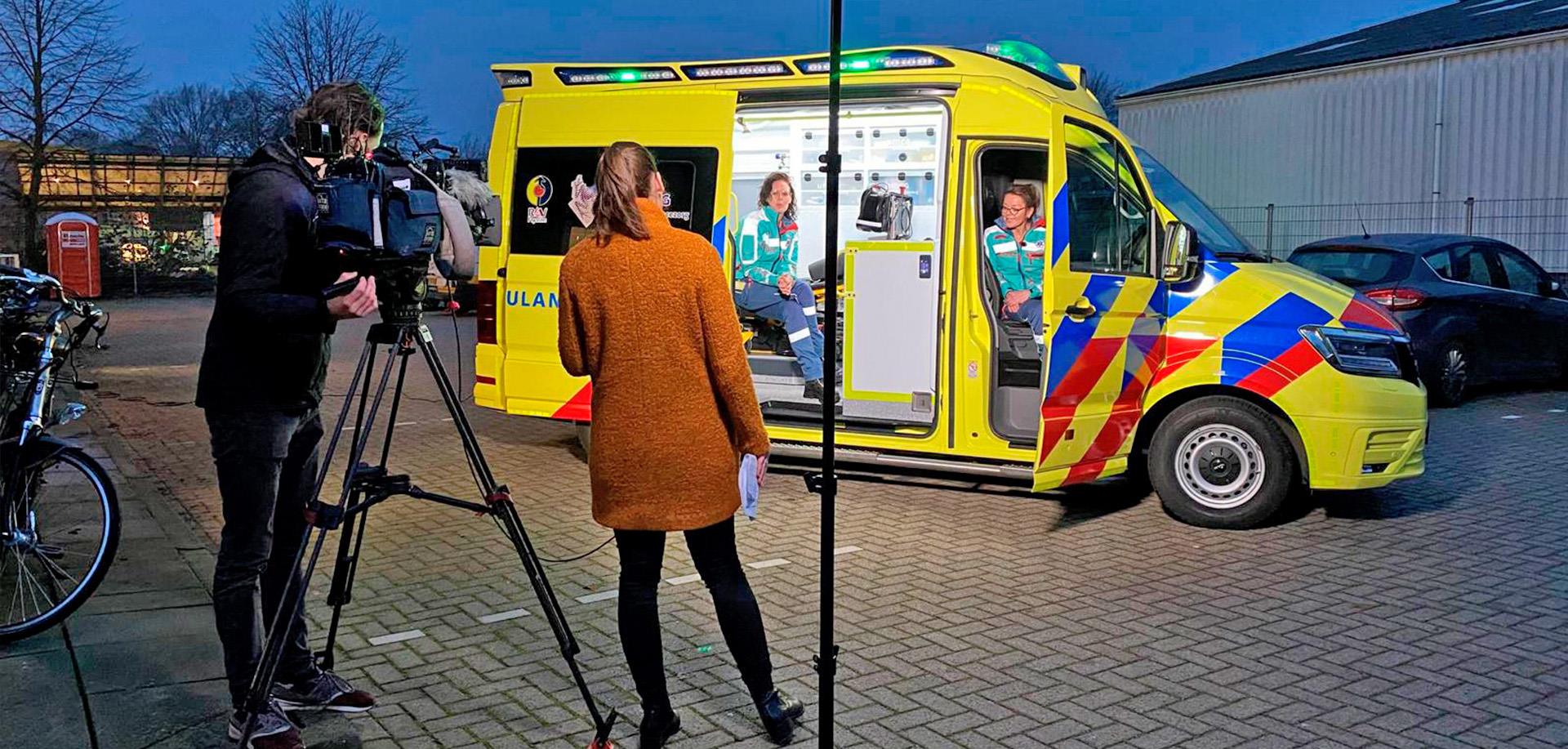
Featured ComponentsR & D · TECHNOLOGY
-
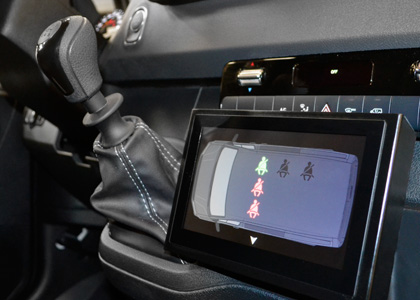
SEAT SENSOR
AMBULANCES EN 1789:2020Control of seat belts in the patient area
The system allows the driver to monitor the state of the seat belt in the seats occupied in the patient compartment. The seats have pressure sensors that detect when the seat is in use. When the belt is not fastened, the driver is alerted by a warning light and an audible warning.
ADVANTAGE
- Improves safety by helping to detect occupied seats without the seat belt fastened.
- Double visual and sound alert for the driver.
- The CARLA touch screen in the driver's cab allows visual and intuitive identification of each of the rear seats.
- In compliance with the new requirements of the European Standard EN 1789:2020
-

EXTERNAL LIGHTING
EN 1789:2020External lighting of the patient compartment
To maintain lighting in the entire environment of the patient compartment, Type C and Type B ambulances with bodies according to the new requirements of the European Standard EN 1789:2020 are equipped with a set of white LED spotlights on the lower perimeter of the vehicle, which complement the lighting of integrated area in the spoilers RLAF1, RLAF2, RLAF3 and RLAF4. This double system achieves excellent lighting at short and medium distances from the ambulance work area, in addition to improving the visibility of the vehicle when it is stopped.
ADVANTAGE
- Better lighting of the work area in the ambulance environment.
- Automated activation / deactivation according to the state of the ambulance.
- Greater visibility of the vehicle.
- In compliance with the new requirements of the European Standard EN 1789:2020
-

Projected floor
ALL CONVERSIONSProjected floor
The projection of the epoxi type paint on the floor with elevation in the skirting of all the contour creates a watertight zone that facilitates cleaning and disinfection. The surface is slightly rough to achieve slip-resistant certification even on wet floors. In addition, it is resistant to chemical agents and disinfection.
The choice of the base color combined with the roof, seats and other elements allows the interior tone to be adapted to the corporate image of the emergency service.
-

Furniture
ALL CONVERSIONSSeamless finish
The joints, edges and joints of the plastic panel remain sealed by means of a surface finish system of the entire patient compartment. This avoids the use of edges of different material for the finishes, which with the use and cleaning of the ambulance tend to weaken, facilitating the filtration of fluids, the presence of odors and poor disinfection of the ambulance.
The RLA interior surface finishing process avoids these problems and complements it with the lacquering of the interior of the access doors to the patient compartment to achieve a uniform finish of the entire interior.
-

RLAF4
FRONT SIDE SPOILERThe perfect complement to RLAF2
With four signaling modules made up of two front and two side optics, it improves the visibility of the ambulance from the entire front and side perimeter. The RLAF4 spoiler is comprised of a total of 24 sets of high intensity LED strobe lights and 4 white sets (two per side) of area lighting.
It is the perfect match for the RLAF2 rear spoiler. The set ensures 360º coverage with side/rear area lighting and integrated amber directional light bar.
ADVANTAGE
- Increased safety thanks to visibility from any front and side angle.
- Aerodynamic design for lower consumption.
- Integrated work lighting on both sides.
- Ideal complement to the RLAF2 rear spoiler.
-

RLAF2
REAR SPOILER FOR AMBULANCEModular Emergency Signage
RLAF2 was created as the cornerstone of combination with other emergency signaling devices on the vehicle, such as a light bridge or the RLAF4 front module. Developed to measure for each vehicle model, it adapts perfectly to the bodywork. The aerodynamic design favors lower fuel consumption by reducing resistance, as well as offering greater traction, stability and driving safety by improving the chassis' push towards the ground.
Following the RLAF1 philosophy, it is located in the upper area of the ambulance, preventing the opening of the doors from eclipsing the rear and rear side cover lights. It also integrates rear area lighting (work light) and optionally amber or two-tone directional light bar, changing the lights in the latter case of color, depending on whether the vehicle is stopped or running.
ADVANTAGE
- Modular design that can be combined with other signaling devices
- Greater safety thanks to rear visibility of more than 180º
- Better traction, stability and driving safety
- Aerodynamic design for lower consumption
- With customization options
-
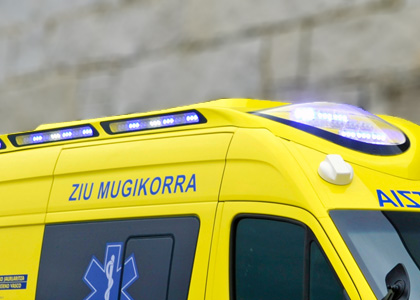
RLAF1
LOW PROFILE SPOILEREmergency signage in compact format
The low profile RLAF1 reduces the overall height of the ambulance by up to 9 centimeters while maintaining all the original design features in terms of functionality: high intensity optical emergency signaling, side / rear area lighting and rear directional light bar. It is a practical solution for those emergency services with special height requirements due to the structure of the base or other reasons.
RLAF1 can also be complemented with a solar panel on the roof to support electricity consumption and charging of the vehicle's batteries.
ADVANTAGE
- Greater safety thanks to visibility from any angle.
- Aerodynamic design for lower consumption.
- Integrated work lighting on both sides and at the rear.
- Amber rear turn signal bar to divert traffic when the ambulance is stopped.
- Bitonal amber / blue lights on the rear directional bar that operate in blue strobe mode when the ambulance is in motion.
-

Custom Interior Ceiling
ALL CONVERSIONSCustom Interior Ceiling
It is available in various models adapted to the needs of each transformation. With extraction / ventilation aerators and LED light bars throughout the cabin with adjustable intensity of illumination and twilight light, it can incorporate adjustable spotlights at various points, handles, IV pole, speakers, sunroof and other services.
Built in a single piece of great lightness, robustness and resistance, it can be customized to each of the different vehicle models.
-

Backlighting
ALL CONVERSIONSBacklighting and indirect lighting
As an option, the interior lighting of the cabinets with transparent, translucent or opaque fronts facilitates the work of the technicians when accessing the material stored in the vehicle.
Indirect lighting is also available in recommended use areas to improve ergonomics and prevent accidents, such as the grab bars or the passenger compartment access step, among others.
-
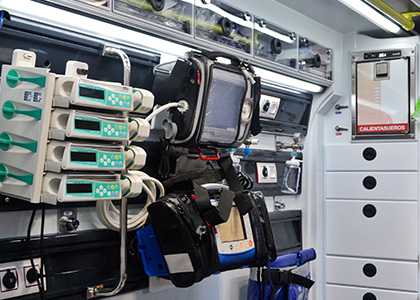
Electromedicine Stands
CARE AMBULANCESSliding strip integrated in furniture
With the aim of improving ergonomics, the supports of the electromedical equipment are installed on a system of guides that allows to modify the longitudinal position of each device and achieve an optimal location. As a complement, all the necessary electricity and oxygen outlets and a specific lighting bar for the set are integrated.
-

Seats
ALL CONVERSIONSSeats with special functions
The seats of the assistance cabin of an ambulance in particular and of any special vehicle in general, must have specific characteristics in addition to those of transporting users and professionals in a comfortable and safe way.
This type of work seat must be able to be moved, collected, assembled and disassembled easily, as well as have special measures and equipment incorporated. They are designed and approved to facilitate the work of professionals and that they can be adapted to the different needs of each type of work.
All of them incorporate a three-point seat belt and fastened belt sensors with warning light and alarm sound in the driving position.
As a measure of adaptation to the corporate image of each transformation, the upholstery is available in various shades and fabrics.
Optionally, other specific seats requested by the client can be incorporated.
-

Sliding Seat
ALL CONVERSIONSFolding seat with sliding base
This type of seat is very important for type B and type C ambulances since it allows two seats to be placed together on the right side and that both are oriented towards the stretcher when they are in a lateral position and to seat two people when facing towards the direction of travel.
This system gains space for the furniture without forcing that at least one of the seats has its back to the stretcher when it is in a lateral position or that one of them cannot seat a person in the direction of travel.
-
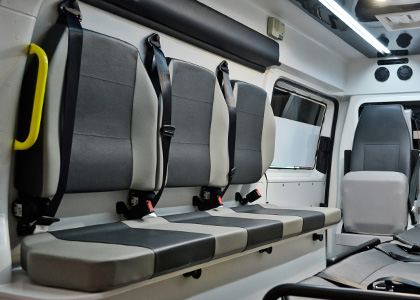
Continuous Dual-Use Side Bench
CARE AMBULANCESContinuous Dual-Use Side Bench
This system is incorporated for markets and types of vehicles where the use of this type of seats is allowed. It incorporates an anatomical backrest and a three-point seat belt for each seat and a support for a spinal board. The table top can be used in an emergency to transfer a second patient lying on the bench using special belt anchors.
-

HANSWAV
AMBULANCES AND WAVHead Retention Device for Adaptive Transport Vehicles
HANSWAV is a head restraint system for wheelchair seats in adapted transport vehicles and transport ambulances.
When it is collected it does not occupy space nor does it pose any obstacle to mobility within the vehicle. Once folded down, it can be configured both longitudinally and in height to adapt to the position of the passenger's head. In this way, safety is improved by reducing the possibility of neck injury in the event of an accident, and user comfort is improved by offering support to support the head.
-

Lifting Platform
WAV TRANSPORTAutomatic Lifting Platform
In vehicles for the transport of people with reduced mobility and ambulances for transport without stretchers, the range of automatic platforms available makes it easy to load and unload wheelchairs in complete safety. Depending on the model they can load up to 350 Kg in a simple process by using the built-in control.
-
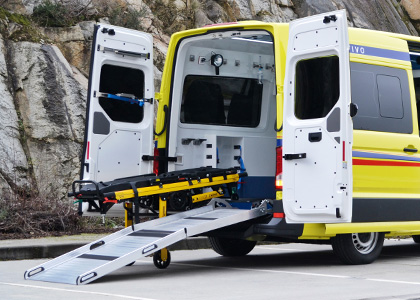
DUPLEX Manual Ramp
WAV TRANSPORT · TYPE A2DUPLEX Manual Ramp
Light and strong, it can be operated with one hand and allows manual loading of wheelchairs with very little effort thanks to the low angle of inclination and the non-slip surface. In the folded position it is very compact, leaving space for fixing and transferring wheelchair users.
In Type A2 collective transport ambulances, it leaves enough space to place the stretcher in parallel without interfering with its accessibility. Wider models are equipped in specific vehicles for the transport of people with reduced mobility PRM that facilitate the loading of larger wheelchairs with greater comfort.
-

Side Step
ALL CONVERSIONSAutomatic or manual side step
The running board significantly facilitates access to the interior through the side sliding door. The automatic exterior step extends and retracts autonomously when the door is opened, and can be disabled using the controls in the driver's cab. The interior manual running board is another great option, it folds and folds easily, avoiding the possibility of accidental damage with sidewalks or other urban elements.
Other fixed exterior running boards and direct or indirect lighting are also available as an option.
-
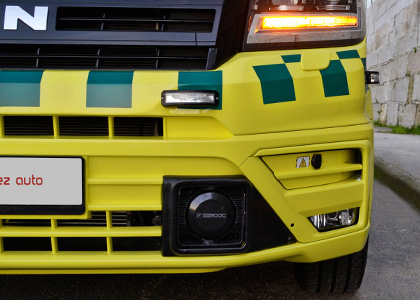
Siren
EMERGENCY VEHICLESHorn loudspeaker integrated in the bodywork
The siren loudspeaker blends in with the vehicle functionally and consistently by fully integrating into the front bumper.
-

Refrigerated ampoule holder
EMERGENCY AMBULANCESRemovable refrigerated ampoule holder
With an innovative design to integrate perfectly into the ambulance furniture, this ampoule holder offers a safe and efficient solution for the storage of temperature-sensitive products.
Main Features
Perfect Integration: It is installed directly into the ambulance furniture, optimizing space and facilitating access.
Advanced Cooling System: It uses Peltier cells to maintain a constant temperature, capable of reducing up to 15°C depending on the ambient temperature.
Easy Extraction: Equipped with a shutter and a lock with key, it allows for quick and safe extraction when necessary.
Intelligent Control: Manages temperature and other functions through the CARLA 4.0 system touch screen, guaranteeing precise and continuous monitoring.
Benefits
Safety and Efficiency: Ensures that medications are kept in optimal conditions, reducing the risk of deterioration.
Quick Access: The removable function allows immediate access to supplies in emergency situations.
Cutting-edge Technology Control through CARLA 4.0 provides an intuitive and easy-to-use interface, improving the operability of the medical equipment.

We Serve Who Save Lives








